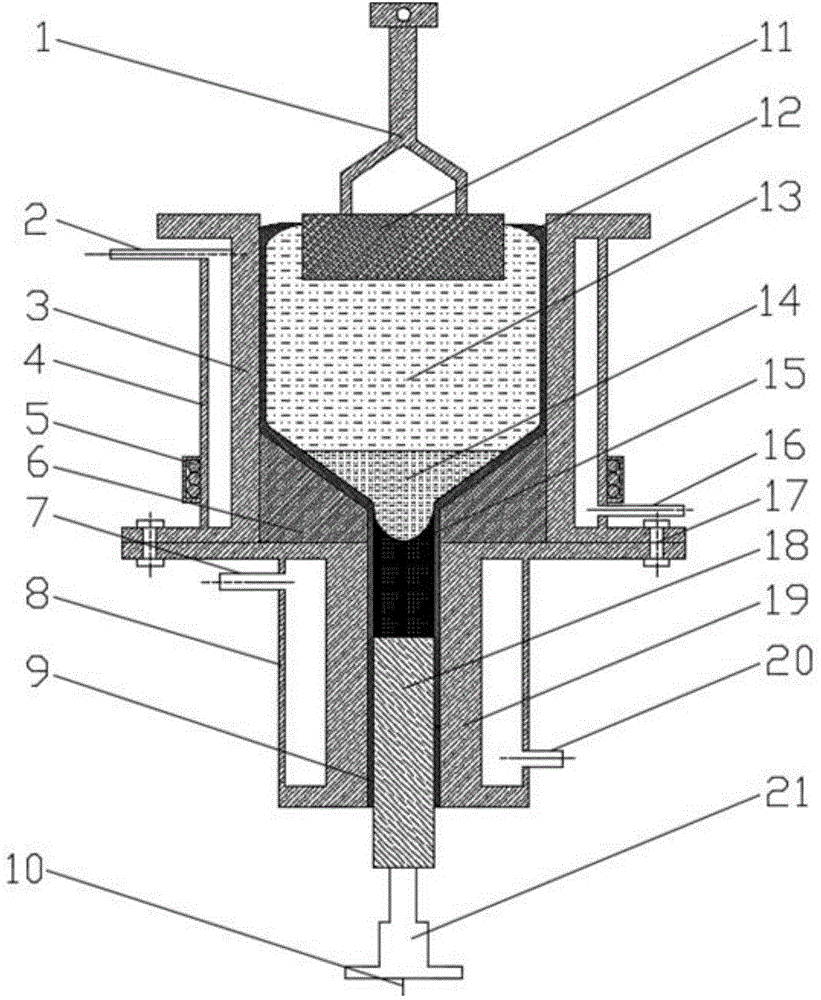Method and device for preparing rare-earth metal through lower cathode electrolysis and in-situ ingot casting synchronization
A technology of rare earth metal and cathodic electrolysis, which is applied in the direction of cells, etc., can solve the problems of difficult operation for workers, enlarged cell scale, and high comprehensive cost, so as to improve surface quality and internal crystallization structure, improve quality and yield, and solve furnace problems. The effect of large temperature fluctuations
- Summary
- Abstract
- Description
- Claims
- Application Information
AI Technical Summary
Problems solved by technology
Method used
Image
Examples
Embodiment 1
[0024] As shown in the drawings, the electrolytic furnace of the present invention has a diameter D=600mm and a height of 800mm, and is placed on the ingot casting furnace. Before power on, open the cooling water valves of the upper and lower parts of the equipment at the same time, the cooling water flow rate is 30L / h, and place the dummy rod tungsten rod in the ingot cavity of the ingot casting furnace as the cathode. The pre-melted molten salt electrolyte (NdF 3 : LiF=9:0.9) is poured into the hearth of the electrolytic furnace, the cuboid graphite anode with a length of 450mm, a width of 450mm, and a height of 300mm is inserted into the molten salt electrolyte of the hearth of the electrolytic furnace, and the automatic lifting and feeding device of the carbon anode is opened. At a temperature of 1100°C, turn on the power supply for constant current electrolysis, and the anode current density is 0.9A / cm 2In the process of electrolysis, about 5.5Kg of neodymium oxide is ad...
Embodiment 2
[0028] As shown in the drawings, the electrolytic furnace of the present invention has a diameter D=600mm and a height of 800mm, and is placed on the ingot casting furnace. Before power on, open the cooling water valves of the upper and lower parts of the equipment at the same time, the cooling water flow rate is 30L / h, and place the dummy rod tungsten rod in the ingot cavity of the ingot casting furnace as the cathode. Pour the pre-melted molten salt electrolyte (LaF3:LiF=9:1) into the hearth of the electrolytic furnace, insert a cuboid graphite anode with a length of 450 mm, a width of 450 mm, and a height of 300 mm into the molten salt electrolyte in the hearth of the electrolytic furnace, Turn on the carbon anode automatic lifting and feeding device, and at a temperature of 1000°C, turn on the power supply for constant current electrolysis, and the anode current density is 0.8A / cm 2 In the process of electrolysis, about 5.2Kg of lanthanum oxide is added directly to the ano...
Embodiment 3
[0032] As shown in the drawings, the electrolytic furnace of the present invention has a diameter D=600mm and a height of 800mm, and is placed on the ingot casting furnace. Before power on, open the cooling water valves of the upper and lower parts of the equipment at the same time, the cooling water flow rate is 35L / h, and place the dummy rod tungsten rod in the ingot cavity of the ingot casting furnace as the cathode. Pour the pre-melted molten salt electrolyte (PrF3:LiF=9:1.2) into the hearth of the electrolytic furnace, insert a cuboid graphite anode with a length of 450 mm, a width of 450 mm, and a height of 300 mm into the molten salt electrolyte in the hearth of the electrolytic furnace, Turn on the carbon anode automatic lifting and feeding device, and at a temperature of 1100°C, turn on the power supply for constant current electrolysis, and the anode current density is 1A / cm 2 In the process of electrolysis, about 5.5Kg of praseodymium oxide is added directly to the ...
PUM
| Property | Measurement | Unit |
|---|---|---|
| diameter | aaaaa | aaaaa |
| height | aaaaa | aaaaa |
| height | aaaaa | aaaaa |
Abstract
Description
Claims
Application Information
 Login to View More
Login to View More - R&D
- Intellectual Property
- Life Sciences
- Materials
- Tech Scout
- Unparalleled Data Quality
- Higher Quality Content
- 60% Fewer Hallucinations
Browse by: Latest US Patents, China's latest patents, Technical Efficacy Thesaurus, Application Domain, Technology Topic, Popular Technical Reports.
© 2025 PatSnap. All rights reserved.Legal|Privacy policy|Modern Slavery Act Transparency Statement|Sitemap|About US| Contact US: help@patsnap.com

